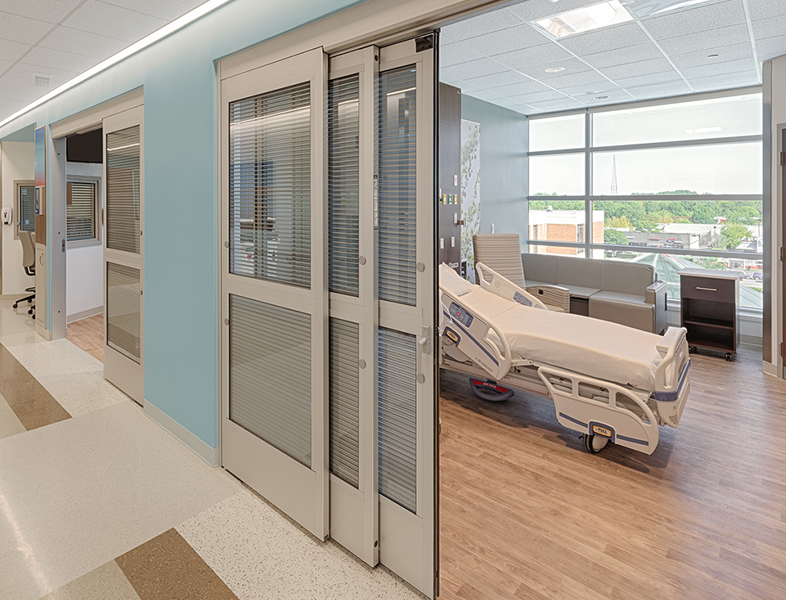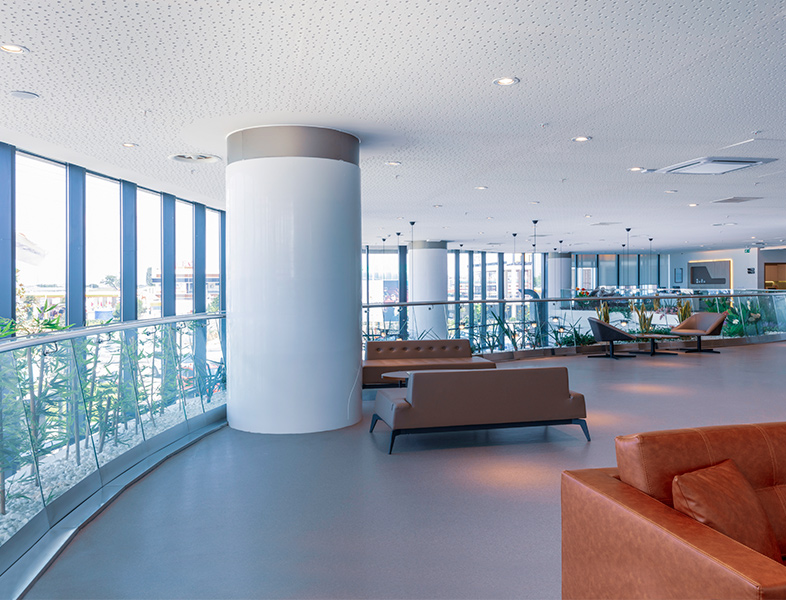Restaurant-quality meals. Fancy, open-air lobbies with comfortable furniture. Artwork on the walls and a focus on natural light and views of nature.
While the description above may sound a little like a new hotel, it’s actually a list of steps recently taken by several health systems in facilities across the U.S. to improve the patient experience.
We’ve entered the age of “better healing through better hospital design,” according to Center for Health Design research associate Melissa Piatkowski. That means a much-expanded emphasis on amenities and other design elements to not only keep patients happy, but also to improve health outcomes and the speed of healing.
While the intense pressure of the pandemic highlighted the need for change in hospital design, the movement to improve patient experiences had already begun long before Covid-19.
Why improve patient experience through design?
Several factors have spurred health systems and hospitals to place more value on – and invest more in – the patient experience.
In the U.S. – where health systems compete against one another, telehealth is on the rise, and facilities are reimbursed for improving patient satisfaction – it just makes good business sense. A Deloitte report from a few years ago showed that hospitals with excellent ratings from the CMS Hospital Consumer Assessment of Healthcare Providers and Systems (HCAHPS) patient satisfaction survey had significantly higher profit margins than lower-rated hospitals.
Improved patient experiences can also lead to better health outcomes and patient satisfaction, as demonstrated in a much-referenced study on recovery times by Dr. Roger Ulrich of Sweden’s Center for Healthcare Building Research at Chalmers University of Technology. The study indicated that views of nature encouraged faster healing and led to less medication consumption.
In an interview with the New York Times, Dr. Ulrich said the study was influenced by his own experience years earlier. “As a teenager, I had some serious illnesses that forced me to spend time at home in bed,” he’s quoted as saying. “My window was my compass of stability. Every day, I watched the trees in the wind. There was something endlessly calming about it.”
Other studies since Dr. Ulrich’s have unearthed similar results. In one, bipolar patients placed in rooms with plenty of natural sunlight were in hospital for four fewer days than similar patients in rooms with less natural light. A similar study concluded that psychiatric patients don’t need as much anxiety medication when surrounded by photos of landscapes (even compared to abstract art). And a third study showed that views of nature lead to a better mental outlook, lower blood pressure, and higher pain tolerance.
Design considerations to improve patient experience
It’s largely for these reasons that health systems have begun investing significant resources to improve patient experiences.
Opened in 2016, the Memorial Sloan Kettering Cancer Center is one of those hospitals designed from the outset to meet patient needs through several unique features. Figure-eight walking paths on some floors allow patients with limited mobility to walk without feeling pressure to go too far, while artwork on the walls provides visual stimulation. Each patient room has its own bathroom and is equipped with video conferencing technology so patients can video chat with family and friends.
But what are other hospitals doing to improve patient experience?
- Improved lighting and outdoor spaces. We’ve already mentioned the impact natural light and views of nature have on patients (and staff, for that matter): It improves mood and encourages healing. Hospitals have now begun to introduce gardens and other landscaping open for patients to walk or simply hang out in quiet, natural surroundings while reducing their dependence on bright artificial lighting. This article in the respected medical journal The Lancet described these landscaped gardens as “a restorative resource” that helps lower stress, improve quality of life, and encourage physical activity. “We have seen how gardens make a positive difference in patient recovery,” says Jay Kasey, senior vice-president of administration and planning at Ohio State University (which houses the James Cancer Hospital). “When there’s light and accessibility to light, patients heal quicker. We wanted the building to treat patients, not just house them.”
- Reduced noise. Traditional hospitals are, by and large, very noisy places. Indeed, many busy hospitals routinely exceed World Health Organization (WHO) guidelines for hospital noise. This level of noise makes sleep next to impossible for some patients, degrading the healing process and leading to longer and less productive hospital stays. Noise mitigation can include sound-absorbing acoustic panels, quieter staff conversations (especially in shared rooms), and hermetically sealed windows and doors in patient rooms.
- Improved privacy. Most hospitals that value patient experience typically put a high priority on private rooms for patients. Privacy helps with the noise issue mentioned above while allowing patients to be more honest about symptoms with healthcare professionals (it’s not always easy to speak frankly to your doctor when your roommate is on the other side of a curtain). Private rooms have also been shown to reduce airborne, surface-borne, and bacterial infections and can reduce the length of hospital stays.
- Improved amenities. Some hospitals have taken things even further by hiring chief patient experience officers (CXOs), which some studies indicate can lead to higher HCAHPS scores due to the increased emphasis on patient experience. As mentioned earlier, some hospitals have also begun adding hotel-like amenities such as restaurant-quality menus and bright, airy lobbies.
- Improved patient satisfaction awareness through technology. Hospitals don’t have to wait until they receive the results of a patient survey, long after that patient’s discharge, to get a read on their satisfaction. Companies such as Docent Health (acquired by GetWellNetwork in 2021) offer patient sentiment measurement technology that provides insights into patient satisfaction in real-time.
Vision Control® helps improve the patient experience
Unicel Architectural’s Vision Control® advanced louvered glazing technology is designed for healthcare environments. It provides unprecedented control of vision, light, temperature, and sound for better patient experiences and improved patient visibility for staff while allowing for patient privacy through easily-adjusted louvers and excellent noise control.
Vision Control® can be installed in exterior and interior window and door applications. It’s engineered to be germ-free, dust-free, and maintenance-free through cordless louvers hermetically sealed behind glass panes to ensure optimal hygiene, privacy, and comfort.
News and Updates
The latest from Unicel Architectural

Smart Security Hardware: Why Your Next Window May Have Situational Awareness
- Blog, Innovation
Vision Control® Mini in Doors
Product Spotlight - Blog, Product Spotlight


